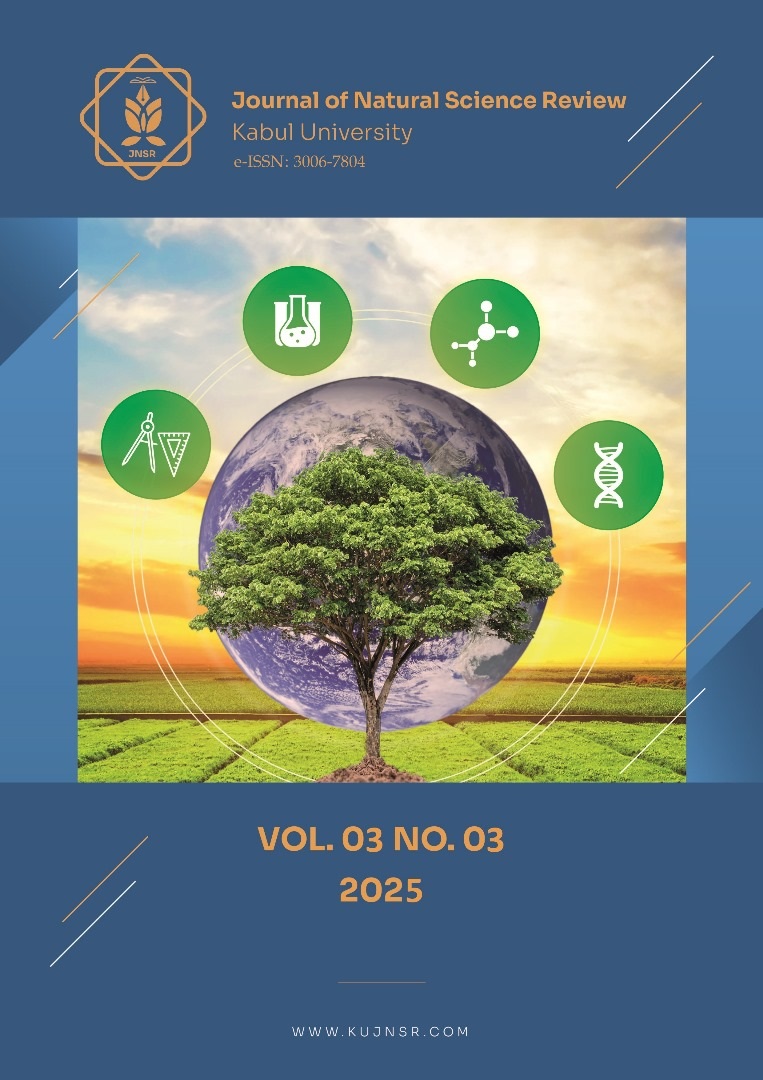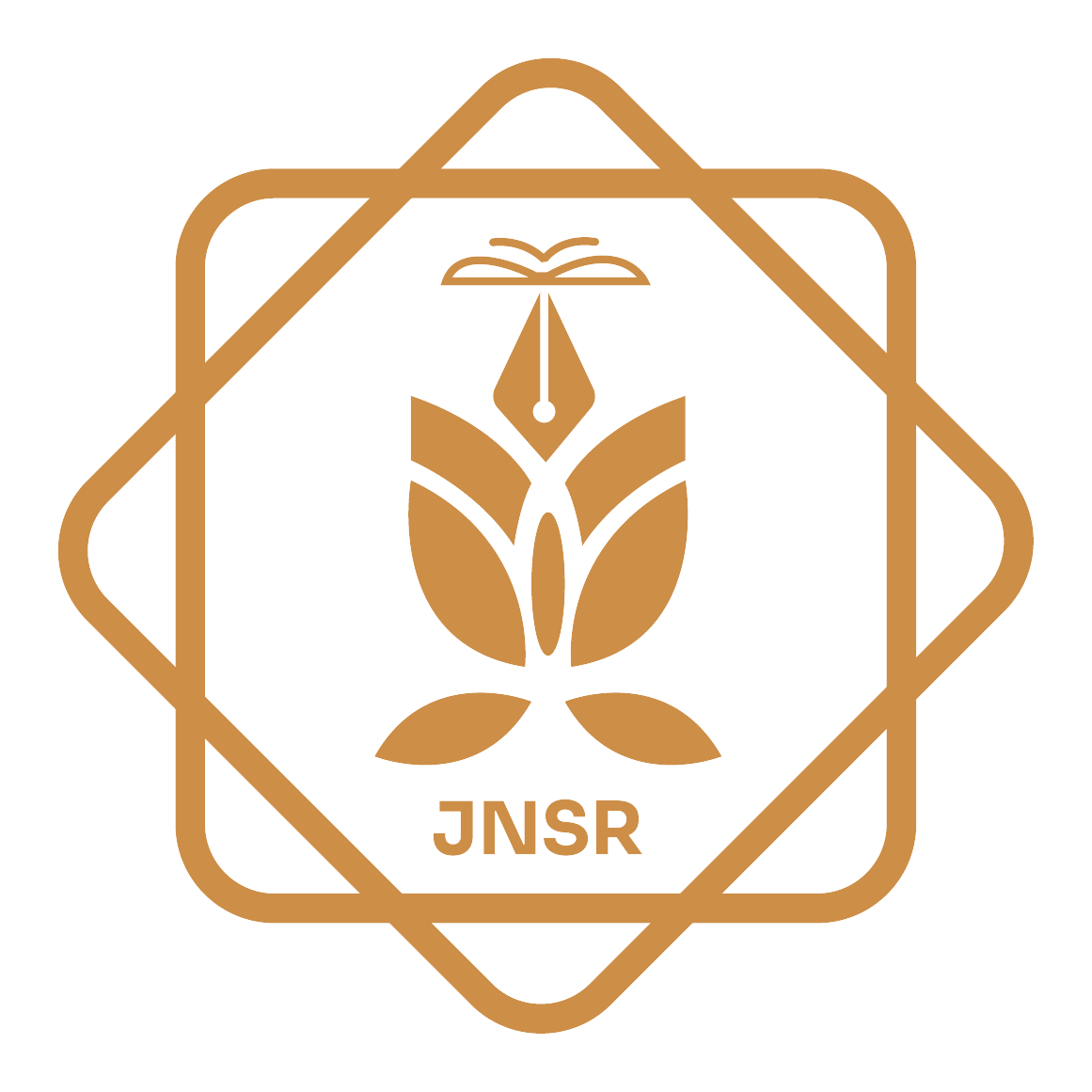Energy Production Potential of Afghanistan: Balancing Renewable and Non-Renewable Energy for National Electrification and Energy Independence
DOI:
https://doi.org/10.62810/jnsr.v3i3.230Keywords:
Afghanistan, Electricity, Energy independence, hydropower, Renewable energy, Solar and wind energy, Sustainable developmentAbstract
The world is transitioning towards renewable energy sources to decarbonize the energy supply and meet the growing global energy demand. In 2023, the global investment in renewable energy reached $1.8 trillion. The progress towards renewable energy in Afghanistan is unclear, and its potential is not clearly identified when compared to non-renewable energy sources. Additionally, the country relies heavily on imported electricity, leading to numerous negative trade-offs in its energy policies and infrastructure. Therefore, this review aims to analyze Afghanistan's energy sector, encompassing demand, access, production, and development, as well as its renewable energy resources, performance, and sustainable impact on the nation. Findings show that Afghanistan has also made progress in small-scale solar projects, as the share of solar energy reached 9.64% in 2022. However, the per capita access to electricity is only 100 kWh, the lowest in the world, and only 20 percent of electricity comes from domestic resources, which are dominated by hydropower. Afghanistan's renewable energy resource potential, including solar, hydro, wind, geothermal, and biomass power, exceeds 300,000 MW. This potential not only meets domestic electricity demand but also could be exported to neighboring countries. Among all these resources, solar energy is the most efficient and cost-effective. Afghanistan is accelerating its renewable energy transition, and the country's authorities must put a strong focus on solar energy, hydropower, and natural gas power sources for a sustainable future and energy security, rather than coal-fired power sources. The information gathered will help policymakers focus on domestic renewable energy to enhance Afghanistan's energy independence
Downloads
References
Asian Development Bank. (2012). Sector Assessment (Summary): Energy, Asian Development Bank. Link
Asian Development Bank. (2017). ADB supports first solar power plant to boost renewable energy in Afghanistan. Asian Development Bank. Mandaluyong City 1550, Metro Manila, Philippines. Link
Akhundzadah, N.A. (2024). Mitigation of Climate Change Through Using Renewable Energy in Afghanistan. In: Chenchouni, H., et al. Recent Advancements from Aquifers to Skies in Hydrogeology, Geoecology, and Atmospheric Sciences. MedGU 2022. Advances in Science, Technology & Innovation. Springer, Cham. https://doi.org/10.1007/978-3-031-47079-0_66 DOI: https://doi.org/10.1007/978-3-031-47079-0_66
Aminjonov F. (2017). Afghanistan's energy security: Tracing Central Asian countries' contribution. Friedrich-Ebert-Stiftung (FES). Link
Afghanistan National Renewable Energy Policy. (2012). Hydropower plants designed to produce electricity. "Afghanistan National Renewable Energy Policy.
Ariana News (2024). Herat company produces 300 solar panels a day.
Arshad M., (2017). Clean and sustainable energy technologies. Clean Energy for Sustainable Development. 73-89. https://doi.org/10.1016/B978-0-12-805423-9.00003-X. DOI: https://doi.org/10.1016/B978-0-12-805423-9.00003-X
Bakkari M., Bossoufi B., El-Kafazi I., Bouderbala M. & Karim M. A. (2024). Review of wind energy potential in Morocco: New challenges and perspectives. Wind Engineering, 48(1), 101-120. https://doi.org/10.1177/0309524X2312005 DOI: https://doi.org/10.1177/0309524X231200582
Barbier E. (2002). Geothermal energy technology and current status: an overview. Renew Sustain Energy Rev 6(1–2):3–65. https://doi.org/10.1016/s1364-0321(02)00002-3. DOI: https://doi.org/10.1016/S1364-0321(02)00002-3
Brown, T. J., Wrighton, C. E., Idoine, N.E., Raycraft, E. R., Shaw, R. A., Deady, E .A., Rippingale J. and Bide T. (2016). World mineral production 2009-14. NERC.
Burns, R. K. (2011). Solar assets, electricity production, and rural energy factors. Renewable and Sustainable Energy Reviews, 15(4), 2144–2148. https://doi.org/10.1016/j.rser.2010.12.002 DOI: https://doi.org/10.1016/j.rser.2010.12.002
Champenois, F. Hummer, L. Lim, J. Pitre. J, Clark. G and Stylianou N. (2024). Boom and Bust Coal: Tracking the Global Coal Plant Pipeline. Global Energy Monitor. Link
Chilvers R., Denmark L. and Howlett M. (2024). Fostering Effective Energy Transition Insite Report. World Economic Forum.
Coleman L. (2024). This is how the MENA region can accelerate its renewable energy production. World Economic Forum.
Cormier C. & Singh J. (2023). The Transition to Sustainable Heating in Central Asia Is Critical and Achievable. The diplomate.
Daniel M. K., Kamal K. & Fripp M. (2006). "Putting Renewables to Work: How Many Jobs Can the Clean Energy Industry Generate?" Renewable and Appropriate Energy Laboratory Report, University of California. Link
Danish, M. S. S., Senjyu, T., Sabory, N. R., Danish, S. M. S., Ludin, G. A., Noorzad, A. S., & Yona, A. (2017). Afghanistan's aspirations for energy independence: Water resources and hydropower energy. Renewable Energy. 113, 1276–1287. https://doi.org/10.1016/j.renene.2017.06.090. DOI: https://doi.org/10.1016/j.renene.2017.06.090
Edward WE. & Qazizai F. (2021). Chinese mining groups scour Afghanistan for opportunities. The Financial Times Limited.
EMBER (2024). Ember Electricity Data Explorer, ember. Link
Ershad A.M. (2017). Institutional and Policy Assessment of Renewable Energy Sector in Afghanistan. Journal of Renewable Energy. (1), 5723152. https://doi.org/10.1155/2017/5723152n. DOI: https://doi.org/10.1155/2017/5723152
Evans S. & Viisainen V. (2024). Wind and solar added more to global energy than any other source in 2023. Swiss Academy of Sciences (SCNAT).
Fahimi A. & Stepputat K. (2023). Low-Carbon Energy Transformation in China, India, Pakistan, and Afghanistan: An Overview. In: S. Groh et al. (eds.), Electricity Access, Decarbonization, and Integration of Renewables, Energiepolitik und Klimaschutz. Energy Policy and Climate Protection, https://doi.org/10.1007/978-3-658-38215-5_5. DOI: https://doi.org/10.1007/978-3-658-38215-5_5
FP Analytics (2023). Mobilizing Financing for Inclusive Development. Link
Gassner, K., Merle-Beral, E., Terenteva, O., Rosenthal, N. & Hankinson, D., (2017). Small Hydro Power Plant in the Kyrgyz Republic: Assessment of Potential and Development Challenges (Organization Report). ESMAP. World Bank. Link
Gayen, D., Chatterjee, R. & Roy, S. A. (2024). Review on environmental impacts of renewable energy for sustainable development. International Journal of Environmental Science and Technology, 21, 5285–5310. https://doi.org/10.1007/s13762-023-05380-z. DOI: https://doi.org/10.1007/s13762-023-05380-z
Hamad J., Ahmad M. & Zeeshan M. (2024). Solar energy resource mapping, site suitability and techno-economic feasibility analysis for utility scale photovoltaic power plants in Afghanistan. Energy Conversion and Management, 303, 118188. https://doi.org/10.1016/j.enconman.2024.118188. DOI: https://doi.org/10.1016/j.enconman.2024.118188
Helper S, Krueger, T and Wial H. (2012). Why Does Manufacturing Matter? Which Manufacturing Matters? A Policy Framework. Brookings. DOI: https://doi.org/10.2139/ssrn.3798089
Hilili, M.J., Akadiri, S.S. & Eneanya, C.N. (2024). Powering Nigeria's future: balancing renewable and non-renewable energy for environmental sustainability. Energy System. 1-22. https://doi.org/10.1007/s12667-024-00686-4 DOI: https://doi.org/10.1007/s12667-024-00686-4
Idoine, N.E., Raycraft, E.R., Hobbs, S.F., Everett, P., Evans, E.J., Mills, A.J., Currie, D., Horn, S. and Shaw, R.A. 2024. World Mineral Production 2018-22. British Geological Survey, Keyworth, Nottingham.
International Energy Agency, (2021) Uzbekistan Energy Profile. International Energy Agency. Link
International Energy Agency, IRENA, UNSD, World Bank, WHO. (2021). Tracking SDG 7: The Energy Progress Report. World Bank, Washington DC. © World Bank.
International Energy Agency, (2022). World Energy Outlook 2022. Link
International Energy Agency, (2023). World Energy Outlook 2023. Link
International Hydropower Association, (2020). Hydropower status report. International Hydropower Association. International Hydropower Association. Link
Institute for Economics and Peace (2022). Ecological threat report 2022: Analysing ecological threats, resilience & peace, sydney.
Irfan Z. (2023). Domestic Manufacturing Is Essential to India's Green Energy Transition. Council on Foreign Relations. Link
Isha F.A. (2024). Bangladesh solar power surge set to unlock thousands of green jobs.
Kabul Times. Kunar power dam’s construction would ease electricity shortages. Link
Khan A.U. (2024). Chinese Dam Construction in Afghanistan: Implications for Pakistan. The diplomate.
Khan H. (2024) Catalyzing Renewable Energy: Path to Afghanistan's Economic Revival. The Diplomat.
Kohsar W (2021). Afghans rely on coal to keep warm as winter cold sets in the harsh Afghan winter. Al-Jazeera.
Komilov A. (2023). How the EU Can Contribute to the Green Transition in Central Asia. The Diplomat.
Lempriere M (2024). Wind and solar are 'fastest-growing electricity sources in history. Link
Li, L., Lin, J., Wu, N., Xie, S., Meng, C., Zheng, Y., Wang, X., & Zhao, Y., (2020). Reviewand outlook on the international renewable energy development. Energy and Built Environment, 3(2) 139-157, http://dx.doi.org/10.1016/j.enbenv.2020.12.002. DOI: https://doi.org/10.1016/j.enbenv.2020.12.002
Ludin G.A. et al., (2024). Power transmission in Afghanistan: Challenges, opportunities and proposals. DOI: https://doi.org/10.3934/energy.2024040
Ludin GA, Nakadomari A, Yona A, et al. (2022). Technical and economic analysis of an HVDC transmission system for renewable energy connection in Afghanistan. Sustainable 14: 14-68. https://doi.org/10.3390/su14031468. DOI: https://doi.org/10.3390/su14031468
Lutz, A. F., ter Maat, H. W., Wijngaard, R. R., Biemans, H., Syed, A., Shrestha, A. B., Wester, P., & Immerzeel, W. W. (2019). South Asian River basins in a 1.5 degrees C warmer world. Regional Environmental Change, 19(3), 833–847. https://doi.org/10.1007/ s10113-018-1433-4. DOI: https://doi.org/10.1007/s10113-018-1433-4
Mainali B, Silveira S. (2013). Alternative pathways for providing access to electricity in developing countries. Renew Energy; 57:299–310. https://doi.org/10.1016/j. DOI: https://doi.org/10.1016/j.renene.2013.01.057
Marlow I. & Curran E. (2021). China Eyes Afghanistan's $1 Trillion of Minerals with Risky Bet on Taliban. Bloomberg.
Mujeeb, M., Safi, L., & Mirzazada, A. (2024). Comparison of Newton Raphson – Linear Theory and Hardy Cross Methods Calculations for a Looped Water Supply Network. Journal of Natural Science Review, 2(2), 75–90. https://doi.org/10.62810/jnsr.v2i2.40. DOI: https://doi.org/10.62810/jnsr.v2i2.40
Mujeeb M. Sahak, K., Safi L., Ahmadzai M R. (2023). Climate Change Impacts and Surface Water Accessibility Analysis in the Ghorband Sub River Basin, Afghanistan. KPU International Journal of Engineering & Technology. 3(01)105-122. Link
Mushwani, H., Arabzai, A., Safi, L. (2025). Evaluation of flood hazard vulnerabilities and innovative management strategies in Afghanistan's central region. Natural Haz. https://doi.org/10.1007/s11069-024-06974-7 DOI: https://doi.org/10.21203/rs.3.rs-4890271/v1
Nagheeby, M., Warner, J. (2018). The geopolitical overlay of the hydropolitics of the Harirud River Basin. Int Environ Agreements, 18, 839–860. https://doi.org/10.1007/s10784-018-9418-9. DOI: https://doi.org/10.1007/s10784-018-9418-9
Najafizada E (2021) Afghanistan could go dark as power bills remain unpaid. Aljazeera.
Nordhaus T. (2024). Why Wind and Solar Won't Solve Climate Change.Foreign policy.
NREL (2016). Focus on creative answers to today's energy challenges to transforming the way the world uses energy. National Renewable Energy Laboratory.
Philipp J. (2022). Renewable Energy in Afghanistan. Borgenproject.org
Plumer B & Popovich N. (2024). As Solar Power Surges, U.S. Wind Is in Trouble. The New York times.
Popovich N. (2024). How Does Your State Make Electricity? The New York Times.
Putz C. (2022). Central Asia Continues to Supply Electricity to Afghanistan. The Diplomat.
Qooyash HR. (2024). Solar Power Project in Kabul Begins, Projected to Produce Ten Megawatts. TOLOnews.
Rahimzoda, S. (2024). Water-Energy Equation in Central and South Asia: A Perspective from Tajikistan. In: Adeel, Z., Böer, B. (eds) The Water, Energy, and Food Security Nexus in Asia and the Pacific. Water Security in a New World. https://doi.org/10.1007/978-3-031-29035-0_4. DOI: https://doi.org/10.1007/978-3-031-29035-0_4
Reyer, C. P. O., Otto, I. M., Adams, S., Albrecht, T., Baarsch, F., Cartsburg, M., Coumou, D., Eden, A., Ludi, E., Marcus, R., Mengel, M., Mosello, B., Robinson, A., Schleussner, C., Serdeczny, O., & Stagl, J. (2017). Climate change impacts in Central Asia and their implications for development. Regional Environmental Change, 17(6), 1639–1650. https://doi.org/10.1007/s10113-015-0893-z. DOI: https://doi.org/10.1007/s10113-015-0893-z
Rostami R., Khoshnava, S.M. Lamit, H. Streimikiene, D. & Mardani, A. (2016). An overview of Afghanistan's trends toward renewable and sustainable energies. Renewable and Sustainable Energy Reviews.76, 1440-1464 https://doi.org/10.1016/j.rser.2016.11.172 DOI: https://doi.org/10.1016/j.rser.2016.11.172
Sabory, N. R., Senjyu, T., Danish, M. S. S., Maqbool Sayed, S., Ahmadi, A., & Saeedi, E. (2021). Post-2000 building industry in Kabul city from sustainability perspective. Sustainability, 13(14), 7833. https://doi.org/10.3390/su13147833 DOI: https://doi.org/10.3390/su13147833
Safi, L. (2024). Review of Afghanistan's development pattern from 2001 to 2021: a relative lack of sustainability, inclusiveness, and prosperity. Journal of Social and Economic Development, 26, 333–352. https://doi.org/10.1007/s40847-023-00268-7. DOI: https://doi.org/10.1007/s40847-023-00268-7
Safi, L., Mujeeb, M., Sahak, (2024). Climate change impacts and threats on basic livelihood resources, food security and social stability in Afghanistan. GeoJournal 89, 85. https://doi.org/10.1007/s10708-024-11077-8. DOI: https://doi.org/10.1007/s10708-024-11077-8
Shah, S., Zhou, P., Walasai, G., & Mohsin, M. (2019). Energy security and environmental sustainability index of South Asian countries: a composite index approach. Ecological Indicator. 106, 105507 https://doi.org/10.1016/j.ecolind.2019.105507. DOI: https://doi.org/10.1016/j.ecolind.2019.105507
Slimankhil, A. K., Anwarzai, M. A., Sabory, N. R., Danish, M. S. S., Ahmadi, M., & Ahadi, M. H. (2020). Renewable energy potential for sustainable development in Afghanistan. Journal of sustainable Energy Revolution, 8-15. http://dx.doi.org/10.37357/1068/jser.1.1.02. DOI: https://doi.org/10.37357//1068/jser.1.1.02
TOLOnews (2022) China Interested in Investment in Coal-Fired Power.
TOLOnews (2024). Boosting Energy: Wind and Solar Projects Progress in Four Provinces.
Tutumlu A., & Aminjonov A. (2023). Central Asia's Great Energy Paradox. The diplomate.
UNDESA_DSDG. (2018). HLPF review of SDG implementation: SDG 7-ensure access to affordable, reliable, sustainable and modern energy for all.
UNDP (2014): Micro-hydro lights up homes and lives in Afghanistan. Link
UNDP (2024). Harnessing the sun to power Afghanistan's development.
UNFCC 2023. NDC Registry.Link
UNHCR (2022). Global Report 2022. Link
UNIDO, ICSHP (2016). The World Small Hydropower Development Report2016. United Nations Industrial Development Organization (UNIDO) and International Center on Small Hydro Power (ICSHP), Vienna and Hangzhou.
Wasti, A., Ray, P., Wi, S., Folch, C., Ubierna, M., & Karki, P. (2022). Climate change and the hydropower sector: A global review. Wiley Interdisciplinary Reviews: Climate Change, 13(2), e757. https://doi.org/10.1002/wcc.757 DOI: https://doi.org/10.1002/wcc.757
White E. and Ding W. (2024). Gridlock in China: spending on network surges to support green energy transition. The Financial Times Limited.
Motyka W. M, Fulghum N, & Jones D. (2024). Global Electricity Review-2024.
World Bank. (2021). Afghan communities reap benefits from a cross-regional energy project. Link
World Bank. (2022). The Global Health Cost of PM2.5 Air Pollution. https://doi.org/10.1596/978-1-4648-1816-.
Zafar M. W., Sinha A., Ahmed Z., Qin Q., Zaidi S. A. H. (2021). Effects of biomass energy consumption on environmental quality: the role of education and technology in Asia-Pacific economic cooperation countries. Renew Sustain Energy Rev, 142:110868. https://doi.org/10.1016/j.rser.2021.110868. DOI: https://doi.org/10.1016/j.rser.2021.110868
Zaheb, H., Obaidi, O., Mukhtar, S., Shirani, H., Ahmadi, M., & Yona, A. (2024). Comprehensive Analysis and Prioritization of Sustainable Energy Resources Using Analytical Hierarchy Process. Sustainability, 16, 4873. https://doi.org/10.3390/su16114873. DOI: https://doi.org/10.3390/su16114873
Downloads
Published
How to Cite
Issue
Section
License
Copyright (c) 2025 Sr. Teaching. Asst. Lutfullah Safi Safi, Kawoon Sahak, Hayatullah Mushwani

This work is licensed under a Creative Commons Attribution-NonCommercial 4.0 International License.



























